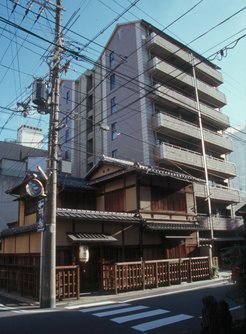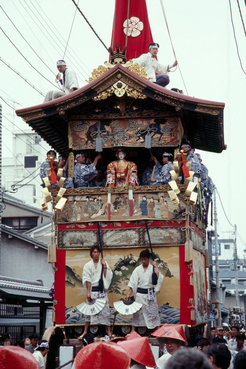Die globale politische Ökonomie des Kulturerbes
Tradition, Democracy, and the Townscape in Contemporary Kyoto

Cultural heritage has also been a key aspect in this open-ended research project which has centred on the conflicts around the townscape and other public traditions of Kyoto, the ancient capital of Japan and acknowledged stronghold of national heritage. Ethnographic field research in 1998/99, 2001, and 2007 (funded by the German Research Foundation [DFG] and the Japan Society for the Promotion of Science) focused on two celebrated traditions, the historic town houses (kyô-machiya) that, after long neglect, are now being renovated for all kinds of modern purposes and the Yamaboko junkô float parade of the Gion matsuri, one of Japan's oldest and most famous festivals. I found that the standard assumptions often held against heritage in social scientific analyses – that it falsifies, petrifies, deprives of substantive content, and socially encloses the things and practices so designated, privileging the official owners and bearers – do not apply here. Instead, history is left relatively undistorted, houses and festival are not forever fixed but allowed to evolve, they are valued not only for their age but also for their other, substantive qualities, and their appreciation has eroded rather than fortified former social boundaries. I relate this to the urban, relatively sophisticated and cosmopolitan background of both traditions that allows for more creativity and eclecticism in dealing with past things than in other cases. For this claim, I find supporting evidence in the (re-)appreciation of urban vernacular architecture and urban festivals elsewhere in the world. I also raise the suspicion, however, that heritage appreciation is often a more complex affair than the standard assumptions lead us to believe.

In addition to the kyô-machiya and the Gion matsuri, my research in Kyoto also dealt with the townscape conflicts peculiar to this city, known as keikan ronsô in Japanese. Landmark building projects such as the proposal to copy the Parisian footbridge Pont des Arts in Kyoto but also ordinary high-rise condominiums have aroused heated opposition, and a wide range of local government agencies, civil society groups, real estate and construction representatives, professional experts, and ordinary Kyotoites have been engaged in a lively public debate about how to best reconcile modern development with Kyoto's historic townscape. Through photo tests and other methods, I could ascertain a widespread consensus among Kyotoites that historic and Japanese-style architecture suits the city best whereas modern high rises are generally unloved. In what I found to be a commons problem, however, most players benefitted from the lack of detailed planning and coordination that, at least in the short term, maximised individual profits. Therefore, public awareness did not translate into public action for the collective good, also because the debate was long left to lower-level bureaucrats and citizen activists while other important actors stayed aloof.
Only in 2007 did the city assembly introduce new building rules, urged on by national legal changes and ministry personnel but also responding to the widespread dissatisfaction articulated by the citizens' groups and major business leaders. Once underway, however, the reform process resulted in the strictest planning regime of any Japanese city, reducing building heights substantially and prescribing historical and vernacular design features. Resistance has been minimal, and investors rush to comply with the new order.
The consequences of this mood shift and other future developments in Kyoto – now widely regarded as a model case in Japan – will be the subject of regular restudies. Kyoto will also be an important comparative case for the research group's other case studies of Istanbul and Melaka. With these, Kyoto shares important features such as its glorious imperial past, its status as former rather than present-day political centre, the lively civil-society debate on how to deal with cultural heritage, and the diversity of this heritage that spans multiple ages and elite as well as commoner structures and is spatially dispersed throughout the cities. We therefore expect both a refined understanding of the single cases and more wide-ranging conclusions on cultural heritage in urban contexts.
Related publications
2014
Heritage Agnosticism: A Third Path for the Study of Cultural Heritage. Social Anthropology 22:173-188.
2012
Tradition, Democracy and the Townscape of Kyoto: Claiming a Right to the Past. London: Routledge. [Supplementary material]
2012
Re-Uniting a Divided City: High Rises, Conflict and Urban Space in Central Kyoto. In: Christoph Brumann & Evelyn Schulz (eds.) Urban Spaces in Japan: Cultural and Social Perspectives, pp. 53-73. London: Routledge.
2010
(with Rupert Cox), Making Japanese Heritage. (Japan Anthropology Workshop Series). Abingdon: Routledge.
2010
Introduction. In: Christoph Brumann & Rupert Cox (eds.) Making Japanese Heritage. (Japan Anthropology Workshop Series), pp. 1-17. Abingdon: Routledge.
2010
Houses in Motion: The Revitalisation of Kyoto's Architectural Heritage. In: Christoph Brumann & Rupert Cox (eds.) Making Japanese Heritage (Japan Anthropology Workshop Series), pp. 149-170. Abingdon: Routledge.
2010
The Limits of Invention: Traditions in Kyoto. In: Susanne Klien & Patrick Neveling (eds.) Tradition within and beyond the Framework of Invention: Case Studies from the Mascarenes and Japan, pp. 177-201. Halle: Zentrum für Interdisziplinäre Regionalstudien.
2009
Outside the Glass Case: The Social Life of Urban Heritage in Kyoto. American Ethnologist 36:276-299.
2009
Traditionen und Kulturerbe in der Japanforschung: Ein Überblick. In: Günther Distelrath (Hrsg.) Referate des 13. Deutschsprachigen Japanologentags. Vol. 2, pp. 369-388. Hamburg: EV-Verlag.
2008
Weite Himmel über der Kaiserstadt: Die Kehrtwende in Kyotos Stadtplanung. Japanstudien 20:103-128.
2007
Copying Kyoto: The Legitimacy of Imitation in Kyoto's Townscape Debates. In: Rupert Cox (ed.) The Culture of Copying in Japan: Critical and Historical Perspectives, pp. 213-229. London: RoutledgeCurzon.
2006
Whose Kyoto? Machizukuri, Local Autonomy and Pâtonashippu in an Old City. In: Carola Hein & Philippe Pelletier (eds.) Cities, Autonomy, and Decentralization, pp. 139-163. London: Routledge.
2005
A Right to the Past: Tradition, Democracy, and the Townscape in Contemporary Kyoto. Habilitation thesis, University of Cologne, Faculty of Philosophy. (revised book manuscript under review).
2005
Kyotos Dilemma: Das Stadtbild als commons [Kyoto's Dilemma: The Townscape as Commons]. In: Werner Pascha & Cornelia Storz (eds.) Wirkung und Wandel von Institutionen: Das Beispiel Ostasien [Institutional Effects and Institutional Change: The Case of East Asia], pp. 133-168. Stuttgart: Lucius & Lucius.
2004
Der urbane Raum als öffentliches Gut: Kyoto und die Stadtbildkonflikte. Zeitschrift für Ethnologie 129:183-210.
2003
Pont des Arts no hakushi tekkai to shimin undô: Kyôto no furansu-bashi wa naze kakaranakatta no ka [The Withdrawal of the Pont des Arts and the Citizen Movement: Why Kyoto's French Bridge Wasn't Built]. In: Hirochika Nakamaki & Mitchell Sedgwick (eds.) Nihon no soshiki: Shaen bunka to infômaru katsudô [Japanese Organisations: The Culture of Associational Ties and Informal Activities], pp. 23-36. Osaka: Tôhô shuppan.
2002
Deconstructing the Pont des Arts: Why Kyoto Did Not Get Its Parisian Bridge. Senri Ethnological Studies 62:15-24. 2001 Machiya vs. manshon: Notizen vom Kyotoer Häuserkampf. Japanstudien 13:153-192.
2001
Machiya vs. manshon: Notizen vom Kyotoer Häuserkampf. Japanstudien 13:153-192.
2001
Die Stadt als Feld: Ethnographische Feldforschung in Kyoto [The City as a Field: Ethnographic Field Research in Kyoto]. In: Hilaria Goessmann & Andreas Mrugalla (eds.) 11. Deutschsprachiger Japanologentag in Trier 1999. Band 1: Geschichte, Geistesgeschichte / Religionen, Gesellschaft, Politik, Recht, Wirtschaft, pp. 595-606. Hamburg: Lit.
2001
Die Blumen von Edo: Zur Brandgeschichte japanischer Städte [The Flowers of Edo: On the Fire History of Japanese Cities]. In: Kunst- und Ausstellungshalle der Bundesrepublik Deutschland GmbH (ed.) Feuer [Fire], pp. 426-442. Köln: Wienand.

